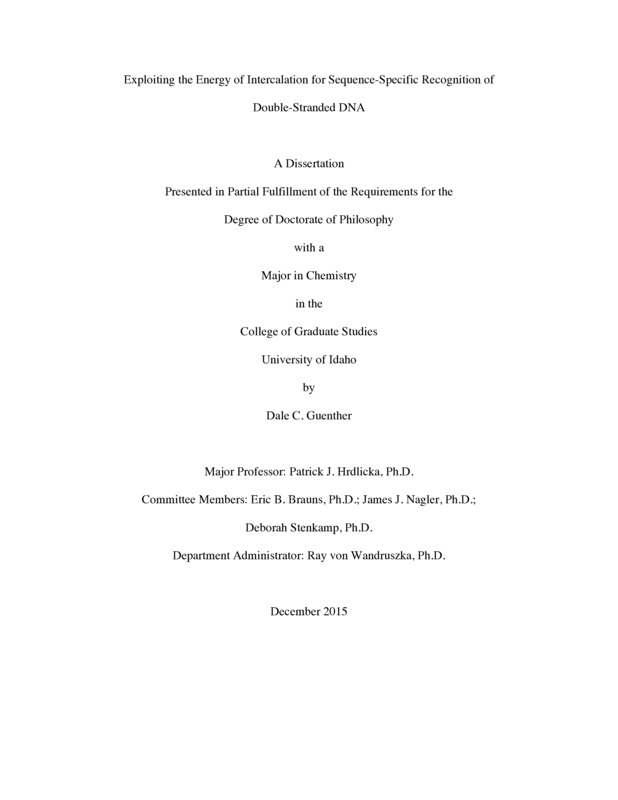Exploiting the Energy of Intercalation for Sequence-Specific Recognition of Double-Stranded DNA
Guenther, Dale. (2015). Exploiting the Energy of Intercalation for Sequence-Specific Recognition of Double-Stranded DNA. Theses and Dissertations Collection, University of Idaho Library Digital Collections. https://www.lib.uidaho.edu/digital/etd/items/guenther_idaho_0089e_10770.html
- Title:
- Exploiting the Energy of Intercalation for Sequence-Specific Recognition of Double-Stranded DNA
- Author:
- Guenther, Dale
- Date:
- 2015
- Embargo Remove Date:
- 2017-12-15
- Keywords:
- DNA recognition Intercalator functionalized nucleotides Invader probes nd-FISH
- Program:
- Chemistry
- Subject Category:
- Chemistry; Nanoscience; Molecular chemistry
- Abstract:
-
There has been great interest in developing probes capable of recognizing specific regions of double-stranded DNA (dsDNA) due to the vast potential of applications in the fields of molecular biology, genomic diagnostics, and DNA nanotechnology. Early efforts focused on targeting the accessible grooves of the DNA helix by means of triplex forming oligonucleotides (TFOs) or pyrrole/imidazole polyamides. However, such attempts have been limited by sequence restrictions and/or requirement for non-physiological conditions. A conceptually more elegant, but also more challenging, approach is to target the buried base pairs of the duplex and utilize the intrinsic Watson-Crick binding rules of nucleic acids. Single-stranded peptide nucleic acids (PNA) have a neutral backbone and bind to complementary DNA with very high affinity, facilitating duplex invasion, albeit at low ionic strengths.
We have introduced Invader probes as an alternative approach for recognition of dsDNA. A mini-review of this approach is presented in CHAPTER 1. These probes are modified double-stranded oligonucleotides that are energetically activated for dsDNA recognition due to the low stability of the probe duplex and high affinity duplexes of each individual probe strand towards complementary dsDNA. The driving force for dsDNA recognition is the result of 2’-intercalator-functionalized nucleotides positioned in +1 interstrand zipper arrangements, termed ‘energetic hotspots’. Major efforts in the laboratory have been focused on optimizing the chemistry of the monomers, while my projects primarily focused on the optimization of the probe architecture and applications of Invader probes. Initially, I set out to determine the influence of the number, location, and distance between the energetic hotspots. Optimal probe designs were then used for sequence-specific recognition of chromosomal DNA in a non-denaturing fluorescence in situ hybridization assay (CHAPTER 2). I then introduce bulged Invader probes, which feature an alkyl bulge in the double-stranded probe, which induces fraying and localized perturbation, resulting in faster and more efficient recognition of dsDNA (CHAPTER 3 and 4). Invader probes capable of photoactivated interstrand cross-linking are presented in APPENDIX A, which results in a covalent bond between the probe and DNA strands, resulting in more persistent binding. Finally, I evaluated Invader probes for inhibition of in vitro transcription (APPENDIX B).
- Description:
- doctoral, Ph.D., Chemistry -- University of Idaho - College of Graduate Studies, 2015
- Major Professor:
- Hrdlicka, Patrick J.
- Committee:
- Brauns, Eric B.; Nagler, James J.; Stenkamp, Deborah
- Defense Date:
- 2015
- Identifier:
- Guenther_idaho_0089E_10770
- Type:
- Text
- Format Original:
- Format:
- application/pdf
- Rights:
- In Copyright - Educational Use Permitted. For more information, please contact University of Idaho Library Special Collections and Archives Department at libspec@uidaho.edu.
- Standardized Rights:
- http://rightsstatements.org/vocab/InC-EDU/1.0/

